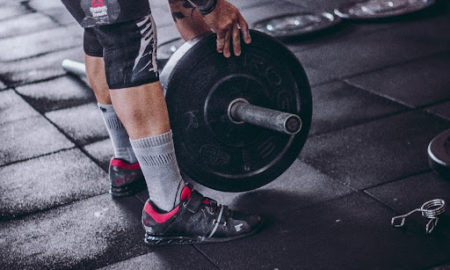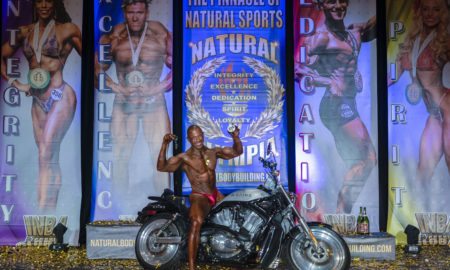Biceps training is a popular topic, so much so that you’re not likely to go a month without coming across a “revolutionary new biceps blaster” in some muscle magazine or on some bodybuilding Web site. For many lifters getting great guns is an all-encompassing goal. Having big ones means the ability to show off at the beach; having small ones means wearing long-sleeved shirts in 90 degree weather—while mumbling some excuse about sunburn.
At 50-plus years old, Lee Apperson knows a thing or two about building big biceps—and part of that knowledge is the reason he doesn’t have a traditional training routine. Instead of doing the same thing every time, Lee is most likely to base his next routine on what he did during his previous workout. His goal is to design his next session to be the polar opposite of his last.
It’s not just about hitting the muscles from different angles; he uses light/heavy, high-rep/low-rep and fast/slow as well. Yes, Lee still uses the curl to get his biceps to grow, and he’s still moving the weight from point A to point B. The fundamental laws of biceps building don’t change, but that doesn’t mean they can’t be tested.
Let’s look at a sample three-week program:
Week 1
Straight-bar curls 3 x 33, 1 x 100, 1 x 12
Nautilus arm machine 1 x 15, 2 x 10
Like me you might look at that first workout and think, “Dang, 100 reps after three set of 33? That’s insane.” It’s also remarkably old school in that long sets stir up memories of giants named Schwarenegger, Zane and Ferrigno. Back when they roamed the bodybuilding world, long, grueling sets were the norm.
Obviously, you don’t want to do this program on a day when you’re planning to move your grandmother’s antique piano—unless you want to find yourself persona non grata at family events. In other words, you’ll be gassed.
“I view working out like a bank,” Lee said, “You have to have energy on hand to make a withdrawal, and if you don’t have enough in your account, if you haven’t made sufficient deposits, then you won’t be able to make it through the workout.”
Another theory on display here is intensity vs. volume. As Lee gets older, he leans more toward volume with lower intensity to prevent injury. That’s reflected in the second workout as well:
Week 2
Flat-bench cable curls 2 x 20, 1 x 15, 1 x 10
Incline curls (three-quarter reps—avoid the top) 1 x 15, 2 x 10
Facedown incline curls 1 x 10, 1 x 8
Apperson was born into the beach culture that thrives along America’s southeast coast. He’s active in skateboarding, surfing and bodybuilding. If it involves being active outdoors, Lee will probably give it a try. He views himself as an athlete first, a bodybuilder second. His goal is to hone his body to be an athletic tool, not just a bodybuilding physique. Because of that he’s willing to try new things that some bodybuilders wouldn’t consider.
Take, for instance, the boot camp fitness challenges put on by his girl-friend Jennifer Micheli.
“When I first started with core strengthening and plyometrics, I was terrible at it,” Lee confessed. “But when I noticed how strong it made my lower back and abs to where I was seeing improvements on my lifts, I decided to make it a regular part of my routine.” There are other goals in bodybuilding besides size. For Lee, fitness plays a bigger role than does sheer mass.
“I could put an extra inch on my arms,” he said, “but would I be willing to do that if it meant putting two inches on my waist?”
The third routine gets even more intense:
Week 3
Two-arm dumbbell curls 2 x 25, 2 x 15, (double drop) 1 x 5(5)(5)
EZ-curl-bar curls (torso bent at 45 degrees) 2 x 15, 1 x 10(8)
He doesn’t reduce the weight for the “drop” on the EZ-curl-bar curls. Instead he stands erect and continues the set, usually getting eight more reps.
If there’s one thing Lee can’t stand it’s people in the gym who spend all day training their biceps without actually hitting them.
“People have developed a whole new workout regimen that allows them to work biceps without ever stimulating the muscle. If you get enough weight, the right angle and the right amount of swing, you can successfully replicate that—just don’t expect to see any gains.”
Not that Lee is against going heavy. He sees just as much value in the principles of powerlifting as he does in the isometric workouts of Bruce Lee. People often forget that there’s benefit in doing both.
“Bruce Lee was the ultimate isometric guy,” Lee observed. “He could do an entire workout standing in a doorway and pushing. If you think that’s easy, try it.”
The key to any successful training is to hit the target muscle. It’s not enough to throw the weight around; you have to have a plan to produce growth. Also important is hitting the muscle group from all angles to develop all parts equally.
“I’m an angle freak,” Lee admitted. “I’ll sit down on a machine and try and figure out ways to change the angle.” He also believes in using free weights as well as machines. The only constant?
Be different.
Changing up your routine is often suggested as a wonderful way to bust through a plateau. Long sets of 100 or more reps are considered something to be used sparingly, if at all, as most publications throw them into the category of special training techniques. For Lee Apperson those techniques just begin to scratch the surface of how he crafts his physique. After more than 25 years in the iron game he knows that shaking things up often gets results.
Editor’s note: Cory Crow is a freelance writer living in Houston. To contact him, write to [email protected]. IM
















You must be logged in to post a comment Login